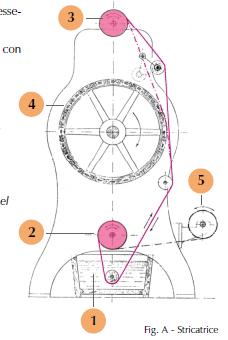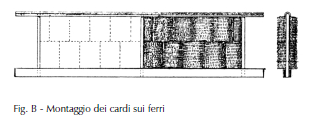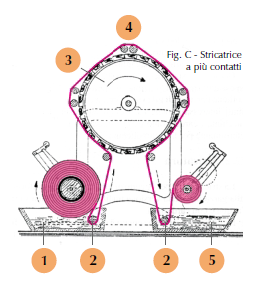© 2024 All rights reserved
Project by UsedTextilemachines.eu
Don't have an account yet? Sign in
Do you already have an account? Go to login Click here
Don't have an account yet? Sign in
Do you already have an account? Go to login Click here
Looking for the best opportunities to satisfy the customer:
Mobile Phone : +393319020189
Working hours: 09.30 / 12.30 - 16.00/18.00 From Monday to Friday.
Striking works on fibers previously raised with the raising process and gives it
a wavy and definitive appearance. It is carried out on pieces previously soaked with water, using
vegetable thistles, preferably already used, so that they have less raising power but
tips still elastic.
The machines that carry out this process can be of two types.
The simplest type involves only one contact of the tissue with
the thistles (see figure A). The constantly wet fabric, passing into the tray below (fig. A, point 1), is alternately wound on two rollers placed one below (fig. A, 2) and the other above (fig. A, 3)
the drum (fig. A, 4) which carries the “irons” (fig. B). Each iron is made up of a rectangular frame in which the vegetable thistles are stably inserted. The action of the drum is always in the same direction,
because its speed is much higher than that of the fabric.
Once the treatment is finished, the fabric is wound on a roller external to the machine (fig. A, 5).

The other machine (fig. C), more productive than the previous one, provides more contact points of the fabric on the cardoons placed on a single drum. The fabric to be subjected to this process passes into a tank (fig. C, 1), where it is soaked in water at room temperature or, in some cases, at 50°C in which auxiliary products can be dissolved; between the tensioning cylinders (fig. C, 2), it slides on the drum (fig. C, 3) where contacts with the cardoons occur.
Four pairs of cylinders (fig. C, 4), placed above the drum, approaching it,
they increase the contact area between thistles and fabric while when they move away this area decreases until it disappears.
The striated piece then passes into a tray (fig. C, 5), becoming still soaked in water; it is then rolled up and remains in this state for a period of 24 hours, always moving, to obtain better fixation and shine of the hair.


The similarities of the machine and the principles with the vegetable gauze are evident; for this reason the behavior
of the operator is completely similar to that adopted for vegetable raising to which
it is postponed.
The only substantial difference is that in vegetable gauze there is a rotary movement of both the drum
that of thistles arranged obliquely, while in the weeder there is a rotary movement of the
drum with the cardoons which are in a horizontal position and fixed.
After the sale of the machinery, we also assist you in logistics and, if desired by the customer, we have technicians capable of reassembling and starting up the machinery.
© 2024 All rights reserved
Project by UsedTextilemachines.eu
| Cookie | Durata | Descrizione |
|---|---|---|
| cookielawinfo-checkbox-analytics | 11 months | This cookie is set by the GDPR Cookie Consent plugin. The cookie is used to store the user consent for the cookies in the "Analytics" category. |
| cookielawinfo-checkbox-functional | 11 months | The cookie is set by GDPR cookie consent to record the user consent for the cookies in the category "Functional". |
| cookielawinfo-checkbox-necessary | 11 months | This cookie is set by the GDPR Cookie Consent plugin. The cookies is used to store the user consent for the cookies in the category "Necessary". |
| cookielawinfo-checkbox-others | 11 months | This cookie is set by the GDPR Cookie Consent plugin. The cookie is used to store the user consent for the cookies in the category "Other. |
| cookielawinfo-checkbox-performance | 11 months | This cookie is set by the GDPR Cookie Consent plugin. The cookie is used to store the user consent for the cookies in the "Performance" category. |
| viewed_cookie_policy | 11 months | The cookie is set by the GDPR Cookie Consent plugin and is used to store whether or not user has consented to the use of cookies. It does not store any personal data. |
Fill out the form to contact me